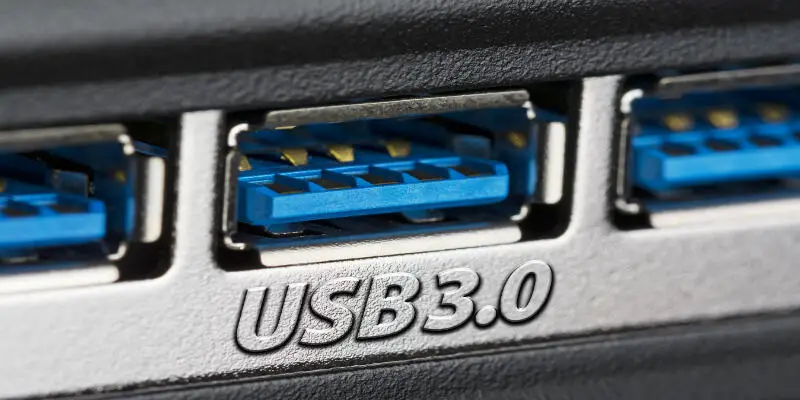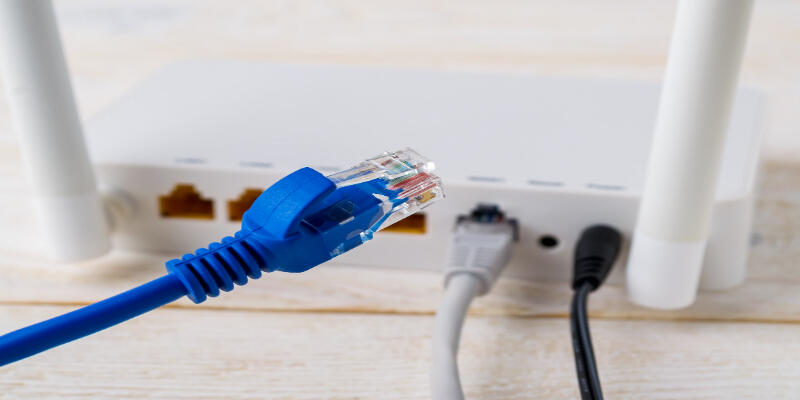Disclaimer: This post may contain affiliate links, meaning we get a small commission if you make a purchase through our links, at no cost to you. For more information, please visit our Disclaimer Page.
USB 3.0 and Ethernet are two popular ways to connect to the internet for computers. But which one is faster?
Generally speaking, USB 3.0 is faster than ethernet. The USB connections’ output totals up to 4800 Mbps, making them about 10x faster than their predecessors, 2.0 version.
Table of Contents
Which Is Faster: USB 3.0 Or Ethernet
USB 3.0 is an improved USB that allows high-speed internet and data transfer (Superspeed USB). Ethernet is a technology that enables the creation of a local area network (LAN), metropolitan area network (MAN), and wide area network (WAN).
Most people who use the internet use it on laptops. The highest data transfer speed of Ethernet 1GB per second in laptops with in-built network interface cards. The USB 3.0 allows internet speeds of up to 5GB/s.
When using these on your laptop, the USB is faster than the ethernet. Recently, with the development of Gigabit Ethernet, their speed has risen from 100mbps to about 100gbps.
If you are sharing data between two or three computers, you can use a USB 3.0, but if you are using several computers, you can use a combination of the two. You can rout out both cables (USB and Ethernet) rather than use one.
However, some people will still pick ethernet ports over the traditional USB port because ethernet cables are compatible across machines. Most computers come with ethernet cables, which in all circumstances are universal. ‘
A good example is standard computer brands vs. Apple devices; the latter is not compatible with most USB devices. A good example is a rivalry between Apple and Android devices. Moving between the two is not always easy.
Pros Of Using USB 3.0
Just like other Universal Serial Buses before it, USB 3.0 allows data sharing between devices only it does so faster. The USB 3.0 has speeds of up to 5000MB/s.
USB 3.0 is efficient. It provides data and can effectively power several devices from one hub, making it efficient in power management. It allows fast charging of mobile phones and other devices.
It requires less power to drive the interconnect; thus, the USB draws very little power from the system
USB 3.0 has increased bandwidth, and it uses two pairs of data wires enabling it to share data without collisions or having to turn the bus (dual simplex architecture). This means that data sharing is possible in both directions at the same time.
Most computers have more USB ports than Ethernet ports making the USB 3.0 more popular and easy to use.
USB 3.0 offers a fast and straightforward network. The USB 3.0 is quite versatile and can connect several hardware easily.
USB 3.0 ports are backward-compatible; if you connect a 2.0 connector device, the port will still read. This means just one USB 3.0 port is enough when connecting two devices.
If your computer cannot support USB 3.0, you don’t have to do a complete system upgrade. You can purchase an adapter and concatenate your devices.
The USB 3.0 has NRDY (Not Ready) and ERDY (Endpoint Ready) packets that allow devices to allow communication between the host and receiver asynchronously. This ensures that links that are not actively passing packets use reduced power.
There are numerous logical streams that can be produced within each endpoint using the Stream protocol.
The USB 3.0 doesn’t have a specified cable length, and you can link them to create a chain. The cables are also portable and do not require sockets.
Cons Of Using USB 3.0
The internet and the connected device will suffer if you are transferring too much data through the same port, as multiple devices connected to the USB will compete with each other and cause the internet and connected device to slow down.
The USB 3.0 is quite expensive as compared to ethernet. Its availability in the market is also quite limited.
For USB 3.0, you have to worry about its compatibility with the devices you are going to use it with.
The maximum cable length for which the USB 3.0 can reliably carry signal is less than 20m making it challenging to share data between very far apart computers.
The USB 3.0 is only compatible with the P55 series of motherboards.
The USB 3.0 supports very few devices and is quite uneconomical if you are working with many computers.
Since the USB 3.0 allows charging of devices, it may quickly drain power from the host computer.
The speed of transfer is as fast as the slowest connected device. If there is a USB2.0 device in the connection, it limits the rate to the USB 2.0 speed.
Wireless devices are at risk for interference with USB 3.0 devices and cables. It may cause devices using Bluetooth or Wi-Fi to be slow or not respond totally.
This means you have to shield or keep Wi-Fi routers and Bluetooth gadgets away from devices using the USB 3.0.
Looking for a solution that protects sensitive data lines without adding signal distorting capacitance is quite challenging to find.
Pros Of Using Ethernet
If you would like to share data between several computers, you can use ethernet to make a local area network with a switch or hub. However, both the switch and the hub must be configured to permit computers to communicate with one another.
Setting up a LAN helps you to play networked games, share files, and connect to network-attached devices and storage.
Ethernet enhances the efficiency of media players and other programs that use files shared on the local area network.
Ethernet cables are pretty cheap and available in almost every networking shop, even the premium quality types. The cost of maintenance is also relatively low.
Ethernet has no client-server architecture, so all nodes have the same privileges.
The original data quality does not change when using ethernet for data transfer.
With both twisted pair cable and optical cable, Gigabit Ethernet has the ability to cover up to 1km with speeds of up to 100 Gbps.
Cons Of Using Ethernet
It is quite expensive and time-consuming to use Ethernet networking. Every computer must have a network interface card (NIC). You will have to purchase extra equipment if your computers do not have Ethernet ports.
In addition, you’d have to spend time hunting for a free slot in the machine to load and install the NIC. Buying and assembling the NIC and the other equipment can difficult.
Ethernet is a connection type designed for networking purposes only, though there have been improvements to allow for data transfer. The data transfer speed for the ethernet is therefore considerably slow.
If you use the ethernet to set up a local area network, keep in mind that the network can only be as fast as the slowest device. Use devices that have the same network connection requirements.
Ethernet offers a nondeterministic connection, therefore not suitable for real time application.
Since the network cannot set priority packets; thus, it is unsuitable for the client-server architecture.
After the reception of a packet, the receiver cannot send an acknowledgment. This is because ethernet operates on connectionless communication and sends data only when the medium is free.
If there is a malfunction, it is difficult to pinpoint a cable or node that is triggering it. This makes troubleshooting a particular line or node challenging.
Ethernet is not a good option for interactive applications. To use it for interactive applications, you’ve got to feed 46B dummy data to form the frame size.
If there is a network overload, the speed drops dramatically, making it unsuitable for traffic-intensive applications. This can significantly affect the effectiveness and quality of work, especially when you are chasing short deadlines.
Ethernet connection doesn’t allow charging of devices.
Conclusion
USB 3.0 and Ethernet have advantages and disadvantages in equal measures. So while choosing, consider your purpose of the purchase, budget, and needs. If your computer requires a system upgrade, I suggest going for the USB 3.0 adapter.


